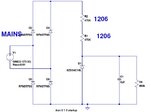T
treez
Guest
Hello,
The 1206 SMD resistors in the attached R/Zener regulator will both have a voltage of some 350V across them during mains transients. Will they be able to survive this?... after all, the overload voltage for a 1206 resistor is 400V.
We could add a SMCJ440A TVS, but these suffer a clamp voltage rise up to 713V during their transient clamping.
SMCJ440A TVS datasheet:
https://www.littelfuse.com/~/media/...s/littelfuse_tvs_diode_smcj_datasheet.pdf.pdf
schematic and ltspice sim attached
The 1206 SMD resistors in the attached R/Zener regulator will both have a voltage of some 350V across them during mains transients. Will they be able to survive this?... after all, the overload voltage for a 1206 resistor is 400V.
We could add a SMCJ440A TVS, but these suffer a clamp voltage rise up to 713V during their transient clamping.
SMCJ440A TVS datasheet:
https://www.littelfuse.com/~/media/...s/littelfuse_tvs_diode_smcj_datasheet.pdf.pdf
schematic and ltspice sim attached
